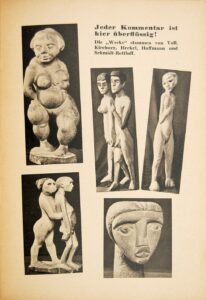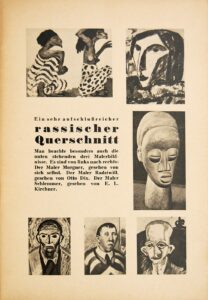Degenerate Art, or “Entartete Kunst,” was a term adopted by the Nazi regime in Germany to denigrate a wide array of modern art.
These pieces, stripped of their dignity and labeled as an insult to German feeling, were often modernist, abstract, or expressionist in nature.
We’ll jump into the harrowing history of these works, exploring how they were targeted and why they were considered a threat to the ideology of the time.
Stay with us as we uncover the stories of resilience and the enduring legacy of the artists behind the so-called Degenerate Art.
Origins Of The Term “degenerate Art”
The label “Degenerate Art” was an invention that would forever change the landscape of modern art.
Initially used disparagingly, the term was embraced in the 1920s by German artists themselves who were fighting against the wave of conservatism.
Ironically, they were seen as a driving force in the avant-garde movement, proudly adopting a label meant to suppress their creative expressions.
Our journey through the cultural shifts of the era reveals that the term’s official and most notorious usage took root in the early 1930s.
The Nazi party, led by Adolf Hitler, weaponized “Degenerate Art” to ostracize and degrade a plethora of art forms.
It marked the beginning of a destructive campaign against modernism, including anything from Bauhaus designs to Dadaist works.
The breadth of work labeled as “Degenerate” was staggering:
- Expressive abstraction, exemplified by Wassily Kandinsky,
- The psychological intensity of Edvard Munch,
- Even the cubistic angles found in the works of Pablo Picasso.
What united these diverse styles under the “degenerate” umbrella was their deviation from the classical art forms the Nazis revered.
The regime’s idealization of Greco-Roman naturalism and the perceived moral purity of neoclassicism was at odds with the innovation and experimentation of modern artists.
The discord highlighted by the term “Degenerate Art” encapsulates the battle between creativity and control.
Characteristics Of Degenerate Art
The category of Degenerate Art encompasses a plethora of styles and movements, identifiable not by a unifying aesthetic but rather by what the Nazi regime deemed culturally corrosive.
Artists caught in this web of ideological censorship included some of the era’s most progressive minds.
Reflecting a spirit of rebellion and social commentary, Degenerate Art often portrayed:
- Non-traditional forms and figures,
- Stark contrasts and vivid color palettes,
- Emotive expressions and subjective worlds Other key features of the allegedly corruptive artworks included abstract representations and techniques that diverged from academic canons established in European art traditions. This represented a direct challenge to the ideals of purity and classicism promoted by the Nazis.
Filmmakers of the time, like artists, encountered a similar fate when their work ventured beyond traditional storytelling or aesthetic norms.
Films using montage, surreal imagery or criticizing societal norms fell under scrutiny.
Our attention to such films highlights the crossover between visual art and cinematic expression – they echo the same revolutionary tone.
Experimental and avant-garde theatre productions, also targeted as Degenerate, shared these characteristics.
By championing works such as these, we honor the rebellious spirit that fuels both film and broader artistic endeavors, refusing to succumb to constraints of ideology or aesthetics.
Our reverence for this aspect of art history underscores the value we place on creative freedom and innovation in all forms of visual expression.
Nazi Propaganda Against Degenerate Art
The Nazi regime mastered propaganda — using every possible medium to convey their ideologies and discredit what they considered subversive or “degenerate.
” Art was no exception, and they launched an aggressive campaign to purge German culture of works that didn’t align with their vision.
At the heart of this campaign was the Entartete Kunst exhibition, organized in 1937, which aimed to ridicule and demonize modern art.
The Nazis strategically juxtaposed the modern pieces with slogans and derogatory commentary to manipulate public perception.
In films and newspapers, the regime disseminated images of degenerate artworks, often with deprecating voiceovers or texts.
This wasn’t merely an attack on aesthetics but a calculated effort to link the art to the alleged moral decay within society.
Specific characteristics were targeted:
- Non-representational forms – Abstract and expressionist art were often ridiculed for their departure from realistic depictions.
- Unorthodox ideas – Pieces that challenged the status quo or presented critique were condemned.
- Jewish artists – The campaign also served as a vehicle for anti-Semitic propaganda, disparaging works by Jewish artists regardless of style or content.
Films produced during this time, such as The Eternal Jew, used art as a symbol of alleged Jewish conspiracy, compounded by theatrical productions that mocked the avant-garde.
The strategy was clear – to associate moral and cultural “decadence” with specific groups and art forms.
The campaign not only censored art but also truncated artistic expression and discourse.
Many filmmakers and theater directors found their work either banned or forcefully tailored to fit the Nazi narrative.
Such restrictions had a chilling effect on the creative community, where the risk of being labeled “degenerate” stifled innovation and experimentation.
As aficionados of visual storytelling, we’re particularly attuned to the symbiotic relationship between narrative and imagery.
The Nazi’s propaganda crusade against what they labeled as degenerate art reveals the power of visual culture in shaping societal values and the peril of politicized censorship.
Our exploration of this dark chapter underscores how vital it is to protect creative expression from authoritarian control.
https://youtube.com/watch?v=lsB_HVVdrek
The 1937 Degenerate Art Exhibition
In one of the most infamous cultural purges in history, the 1937 Degenerate Art Exhibition – Entartete Kunst – was orchestrated by the Nazi regime.
Hosted in Munich, this event became a centerpiece in their campaign against modern art.
We jump into this exhibition to understand the extent of the regime’s influence on the art world.
Dubbed a deliberate act of artistic shaming, over 650 artworks were displayed haphazardly, contrasted against slogans ridiculing the works.
Masterpieces from celebrated artists like Wassily Kandinsky, Paul Klee, and Ernst Ludwig Kirchner filled the congested rooms, their genius intended to be viewed as madness.
- Power in propaganda – key in the Nazis’ mission to homogenize German culture: to define what art should be.
- Misuse of influence – the exhibit exploited the state’s reach to condemn artistic deviation.
Rather than presenting these works as worthy of discussion or appreciation, the Nazis labelled them cultural aberrations.
Pieces deemed reflective of mental illness or societal decline were juxtaposed with didactic texts to manipulate public perception.
Art lost its autonomy amidst this socio-political storm.

The infamous auction of degenerate art at the Galerie Fischer in Switzerland only compounded their plight.

- Loss of diversity – a stifling of the rich tapestry that is human creativity.
- Destruction of heritage – countless artworks were lost forever, a void in our art history.
The lingering effects of the 1937 exhibition reverberate through time, challenging us to reflect on the power structures that govern art.
Its legacy prompts us to consider the role of art in society and the importance of freedom of expression, begging the question – who should dictate what qualifies as art?
Artists And Artworks Targeted By The Nazis
The campaign against what was deemed “degenerate” by the Nazis attacked several key modern art movements.
Expressionism, Dadaism, Surrealism, and Bauhaus all fell under the unforgiving gaze of the regime.
Prominent figures in these movements saw their life’s work derided and, in many cases, destroyed.
Some artists bore the brunt of this classification:
- Marc Chagall – known for his vibrant and emotive works that took from Jewish culture and folklore.
- Wassily Kandinsky – a pioneer of abstract art whose compositions defied the conventional forms of pictorial art.
- Paul Klee – his unique, playful style and use of color was far from the traditional aesthetics favored by the regime.
Art could powerfully communicate ideas and emotions, and the Nazis were intent on squelching any that clashed with their ideology.
Artworks featuring distorted forms and bold colors became prime targets.
The Pillars of Society by George Grosz critiqued the corruption of Weimar’s war profiteers, and Twittering Machine by Paul Klee captured whimsy that the Nazis found intolerable.
These pieces, among many others, were showcased in Entartete Kunst to be publicly scorned.
The breadth of work labeled as “degenerate” encompassed not only visual arts but also film and literature.
Directors like Fritz Lang and authors like Bertolt Brecht found their creations maligned and sometimes banned due to their innovative styles or critical messages.
Through this aggressive censorship, the Nazis aimed to control the cultural narrative and reinforce their ideals.
The push against these artists and their works was militant and all-encompassing, leaving a void where once there was an eclectic and thriving artistic community.
The Legacy Of Degenerate Art
While the term “degenerate” once carried a severe stigma, the legacy of the art once ostracized under this category has undergone a dramatic reclamation.
The very pieces that were once vilified now sit in prestigious museums and fetch astronomical prices at auctions.
Artists like Paul Klee and Wassily Kandinsky, who faced ridicule and suppression, are now esteemed and recognized for their innovation and influence on modern art.
The influence of degenerate art extends beyond the canvas, playing a pivotal role in the film and creative industries.
The avant-garde techniques and radical approaches have been a wellspring of inspiration for filmmakers.
Movements such as expressionism have deeply influenced the visual language and storytelling mechanisms in cinema, from the atmospheric tension in The Cabinet of Dr.
Caligari to the abstracted realities in Pi.
Below are some transformative impacts of degenerate art:
- Encouraged an enduring dialogue on censorship and creative expression.
- Fostered the development of new artistic movements post World War II.
- Contributed to a broader understanding of art’s role in society.
Even though the efforts to extinguish their ideas, the spirit of the artists and their work continues to resonate.
Educational curriculums teach the importance of these art movements, proffering lessons on history, politics, and the unassailable power of creativity.
Their legacy challenges us to question the societal tendencies to uniformity and highlights the value of artistic diversity.
What Is Degenerate Art – Wrap Up
We’ve seen how “Degenerate Art” reflects a tumultuous history where art became a battleground for cultural dominance.
The Nazi regime’s attempt to control and suppress divergent artistic voices eventually failed to extinguish the creative spirit.
Today, we celebrate the very works once condemned, recognizing them as pivotal to the evolution of modern art.
They stand as a testament to the resilience of artistic expression against the forces of oppression.
We honor these pieces not only for their aesthetic and historical significance but also as symbols of the enduring fight for creative freedom.

Frequently Asked Questions
What Is “degenerate Art”?
“Degenerate Art” refers to a term initially used disparagingly to describe art that deviated from classical forms.
The Nazi regime particularly weaponized it in the 1930s to degrade modern art forms that did not align with their ideals.
Who Embraced The Term “degenerate Art” In The 1920s And Why?
German artists embraced the term “Degenerate Art” in the 1920s as a form of rebellion against conservative cultural norms, championing their art’s expressive and innovative qualities.
How Did The Nazi Party Use The Concept Of “degenerate Art”?
The Nazi party used the concept of “Degenerate Art” to ostracize, degrade, and censor art that was non-representational, conveyed unorthodox ideas, or was associated with Jewish artists.
What Was The Entartete Kunst Exhibition?
The Entartete Kunst exhibition, or Degenerate Art Exhibition, was an event orchestrated by the Nazis in 1937 to ridicule and demonize modern art.
Over 650 artworks were displayed in a demeaning manner.
Which Artists And Movements Were Targeted As “degenerate” By The Nazis?
Prominent figures including Marc Chagall, Wassily Kandinsky, and Paul Klee, and movements such as Expressionism, Dadaism, Surrealism, and Bauhaus were targeted by the Nazis in their campaign against modern art.
Why Is The Legacy Of Degenerate Art Important?
The legacy of degenerate art is important because it highlights the resilience of creativity against censorship.
The once vilified artworks are now celebrated for their influence on modern art, contributing to artistic movements post-World War II and fostering discussions on freedom of expression.
How Does Degenerate Art Influence Modern Creative Industries?
Degenerate art influences the modern creative industries by impacting visual language and storytelling in cinema and fostering a dialogue on censorship and creative expression that promotes artistic diversity in society.


